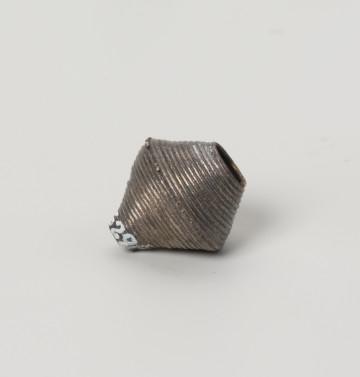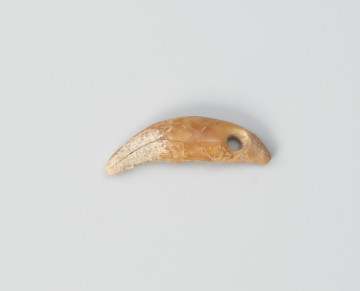
Biconical bead from Lubowidz
80 — 160
National Museum in Szczecin
Part of the collection: Middle Ages
A white, round clay rattle with semi-circular nodules and a single pebble in the centre was deposited in the grave of a deceased child, along with other objects, below his feet. The grave was discovered in an early medieval cemetery in Cedynia and dates back to the late 10th to the 11th century.Rattles had various functions in the early Middle Ages. Before Christianisation, they served as a magical object, as their sound was supposed to ward off all evil forces. They were probably also hung over children's beds to protect their little ones. In this way, they ensured that the youngest children enjoyed the sound of the rattling object, making it a toy as well. Moreover, rattles sometimes served as simple musical instruments. The toys of the early Middle Ages were mainly based on imitation. By playing in this way, children learned social and moral standards. Hence, miniature vessels, boats, sometimes with oars, or martial items such as slings and swords are discovered. These toys reproduced their prototypes extremely accurately. They were made by children and adults alike, often for a different purpose, and only started to be used as toys after some time or when the object was damaged and no longer able to perform its original role. Another group of toys comprised "activity toys". These included spinning tops and buzzers, which produced a characteristic buzzing sound when set in motion by a string. Balls sewn from one or more pieces of leather or bound offcuts also fell into this category. Dexterity toys included astragalus, which were sheep or goat talus bones used for the popular game of dice, also known today. Board game pawns should also be classified as toys, although they were also used by adults. In the early Middle Ages, games such as chess, checkers or the Scandinavian game hnefatafl, which translates as royal table, were known in Pomerania. Ewa Górkiewicz-Bucka
Author / creator
Object type
toy, magic object
Technique
manual modelling
Material
clay
Origin / acquisition method
field research
Creation time / dating
Creation / finding place
Owner
Muzeum Narodowe w Szczecinie
Identification number
Location / status

80 — 160
National Museum in Szczecin

1920 — 1939
National Museum in Szczecin

951 — 1050
National Museum in Szczecin
DISCOVER this TOPIC
Museum of King Jan III's Palace at Wilanów
DISCOVER this PATH
Educational path